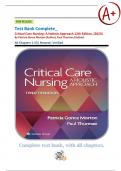Exam (elaborations)
Test Bank Complete_ Critical Care Nursing: A Holistic Approach 12th Edition, (2023) By Patricia G. Morton & Paul Thurman All Chapters 1-53| Newest| Verified| New Release
- Course
- Institution
- Book
Test Bank Complete_ Critical Care Nursing: A Holistic Approach 12th Edition, (2023) By Patricia G. Morton & Paul Thurman All Chapters 1-53| Newest| Verified| New Release Part 1: The Concept of Holism Applied to Critical Care Nursing Practice 4 Chapter 1: Critical Care Nursing Practice 4 Chapter ...
[Show more]



